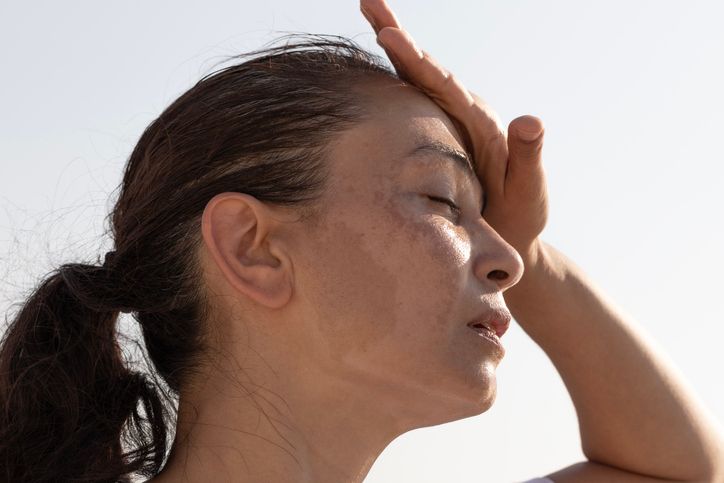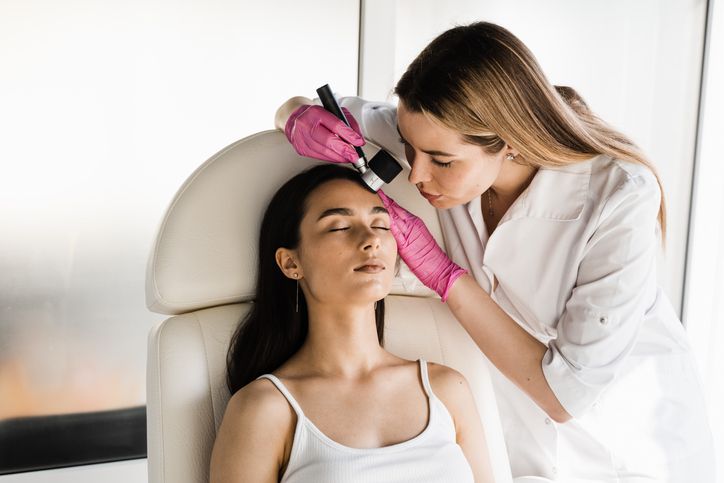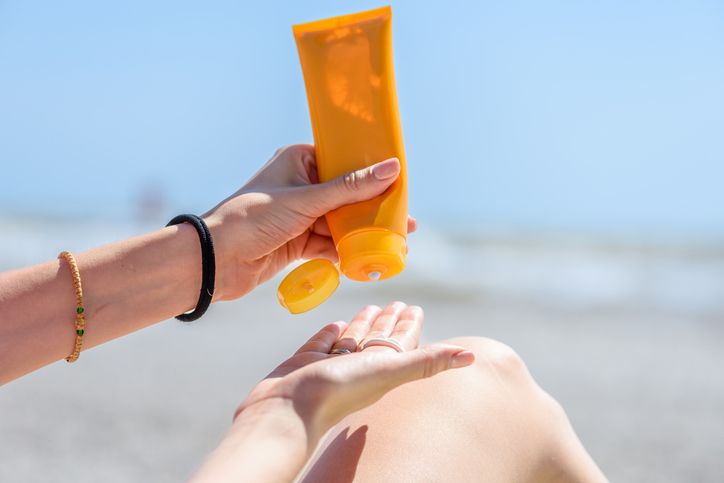- Home
- Trend
- Weight Loss Strategies
- Acne Tips
- Hair Health Information
- Blemish Removal Tips
- Acne Scar Removal Tips
- Muscle Building Techniques
- Intimate Care Tips
- Postpartum Intimate Care
- Eye Bags Wiki
- Tips for Face Slimming
- Secret of Permanent Hair Removal
- Breast Enlargement Tips
- Cure to Snoring
- Marionette Lines
- Skin-Tightening Secrets
Uneven skin tone, dark spots, and age spots – these are all common signs of pigmentation, a skin condition caused by excess melanin production. While generally harmless, pigmentation can be aesthetically bothersome. Here in Hong Kong, with our sunny climate, pigmentation is a frequent concern. But worry not! This blog explores various pigmentation removal treatments available, helping you achieve a radiant, even-toned complexion.
Skin Pigmentation: Causes and Types Explained

Pigmentation issues are a common skin concern that can affect individuals of all skin colour and types. These issues arise when there is an overproduction of melanin, the natural pigment responsible for the colour of our skin, hair, and eyes.
Several factors, including sun exposure, hormonal changes, and skin injuries, can trigger this overproduction. When melanin is produced in excess, it leads to the formation of darker patches on the skin, a condition known as hyperpigmentation. Let's delve into the primary causes and types of hyperpigmentation:
3 Main Causes of Pigmentation Conditions
1. Sun Exposure
Prolonged exposure to ultraviolet (UV) rays from the sun is a significant factor in the development of pigmentation issues. UV rays stimulate melanocytes, the cells responsible for producing melanin, leading to the formation of dark spots on the skin. This is why wearing sunscreen and protective clothing is crucial for maintaining an even skin tone.
2. Hormonal Changes
Hormonal fluctuations, particularly during pregnancy or as a result of taking birth control pills, can lead to a type of hyperpigmentation called melasma. This condition is characterised by brown or greyish-brown patches that usually appear on the face. Hormonal changes can increase melanin production, resulting in these dark patches.
3. Skin Injuries
Any injury to the skin, such as cuts, burns, or even acne, can lead to post-inflammatory hyperpigmentation (PIH). After the skin heals, it may leave behind dark patches or spots due to the inflammatory response that triggers melanin production in the affected area.
Types of Pigmentation
1. Sun Spots (Solar Lentigines)
Sun spots, also known as liver spots or age spots, are a common type of hyperpigmentation that manifests as flat, brown, or black patches on the skin. These black or brown spots predominantly appear on areas of the skin frequently exposed to the sun, such as the face, hands, shoulders, and arms.
Causes:
• Cumulative UV Exposure: The primary cause of sun spots is prolonged and repeated exposure to ultraviolet (UV) radiation from the sun. UV rays accelerate melanin production in the skin as a defence mechanism, leading to the formation of these dark spots.
• Ageing: As we age, the skin's ability to repair itself diminishes, and the cumulative effects of sun exposure become more pronounced. This is why sun spots are more common in older adults.
Characteristics:
• Flat Appearance: Sun spots are typically flat and oval-shaped, making them easy to distinguish from raised skin lesions.
• Colour and Size: They can vary in colour from light brown to black and can be as small as a freckle or up to a few centimetres in diameter.
• Location: These spots commonly appear on areas that receive the most sun exposure, highlighting the importance of sun protection for these regions.
2. Post-Inflammatory Hyperpigmentation (PIH)
Post-inflammatory hyperpigmentation (PIH) is another common type of hyperpigmentation that occurs when the skin darkens after an inflammatory wound has healed. This condition can follow various forms of skin trauma, including acne, cuts, burns, and even certain skin treatments.
Causes:
• Inflammatory Response: PIH is triggered by the skin's inflammatory response to injury. When the skin is damaged, it responds with inflammation, which can stimulate melanocytes to produce excess melanin as part of the healing process.
• Skin Type: Individuals with darker skin tones are more prone to PIH due to their higher baseline levels of melanin.
Characteristics:
• Appearance: PIH manifests as flat spots or patches that can be pink, red, brown, or black, depending on the depth and severity of the skin injury and the individual's skin tone.
• Location: These spots can appear anywhere on the body where the skin has experienced trauma or inflammation.
• Duration: While PIH can fade over time, it may persist for months or even years without treatment, especially in cases of severe skin trauma.
3. Melasma
Melasma is a common skin condition that causes brown or grey-brown patches, typically on the face. It can also appear on other parts of the body exposed to the sun, such as the neck and forearms.
Causes:
• Hormonal Changes: Melasma is often triggered by hormonal changes, such as those that occur during pregnancy, which is why it is sometimes referred to as the "mask of pregnancy."
• Sun Exposure: Ultraviolet light from the sun stimulates the melanocytes in the skin, exacerbating melasma.
Characteristics:
• Symmetrical Patches: Melasma often appears as symmetrical patches on the cheeks, bridge of the nose, forehead, chin, and above the upper lip.
• Colour: The patches are usually darker than the surrounding skin and can range from brown to grey-brown.
• Persistent: Melasma can be a chronic condition, with patches lasting for months or even years.
4. Freckles
Freckles are small, flat, brown marks that appear on sun-exposed areas of the skin, particularly in individuals with fair skin.
Causes:
• Genetic Predisposition: Freckles are primarily genetic and more common in individuals with fair skin and red or blonde hair.
• Sun Exposure: Freckles become more pronounced with sun exposure as UV radiation stimulates melanin production.
Characteristics:
• Small Size: Freckles are small, typically less than 5mm in diameter.
• Colour: They can vary from light brown to dark brown and tend to darken with sun exposure.
• Common Locations: Freckles are commonly found on the face, arms, and shoulders.
5. Seborrheic Keratosis
Seborrheic keratosis is a common, benign skin growth that can appear as a single lesion or multiple lesions.
Causes:
• Age: Seborrheic keratosis is more common in older adults.
• Sun Exposure: Prolonged sun exposure may contribute to the development of these growths.
Characteristics:
• Wart-Like Appearance: Seborrheic keratoses are often raised, with a wart-like surface.
• Colour: They can be brown, black, or light tan.
• Size: They vary in size from very small to more than 2.5 centimetres.
• Common Locations: These growths commonly appear on the face, chest, shoulders, and back.
免費體驗
PicoCure Pigmentation Removal Treatment
1 Minute Self-Registration
Date should not be before minimal date
Treatment Options for Pigmentation Removal

There are a range of effective pigmentation removal treatments available, each tailored to different needs and skin types. Here’s an in-depth look at some popular methods:
1. Laser Treatments
Laser treatments are a highly effective option for pigmentation removal, utilising advanced technology to target and break down pigmented cells:
• YAG Lasers: These lasers are particularly effective for deeper pigmentation issues. They emit light at a specific wavelength that is absorbed by melanin, breaking down the pigmented skin cells. This method is excellent for treating sun spots, age spots, and post-inflammatory hyperpigmentation (PIH).
• Pico Lasers: Pico lasers operate at an even shorter pulse duration, delivering energy in picoseconds. This allows for more precise targeting of pigmented cells with minimal damage to surrounding tissue, resulting in faster recovery and reduced risk of side effects. Pico lasers are highly effective for stubborn pigmentation and provide quicker results compared to traditional lasers.
2. Chemical Peels
Chemical peels involve the controlled application of chemical solutions to exfoliate the outer layer of the skin, revealing a lighter, more even-toned complexion:
• Mild Peels: These use alpha hydroxy acids (AHAs) like glycolic acid to gently exfoliate the skin. They are suitable for individuals with mild pigmentation issues and sensitive skin.
• Medium Peels: Trichloroacetic acid (TCA) is commonly used for medium-depth peels, which can address more pronounced pigmentation problems. These peels penetrate deeper into the skin and provide more significant results.
• Deep Peels: Phenol peels are used for severe pigmentation but are less common due to their intensity and longer recovery time. They are suitable for individuals with significant sun damage or deep pigmentation.
3. Topical Creams
Topical creams are a non-invasive and gradual approach to treating pigmentation:
• Hydroquinone: This is one of the most effective skin-lightening agents available. It works by inhibiting the enzyme tyrosinase, which is involved in the production of melanin. Regular use can significantly lighten dark spots and even out skin tone.
• Kojic Acid: Derived from fungi, kojic acid is a natural skin-lightening agent that inhibits melanin production. It is often used in combination with other ingredients to enhance its effectiveness.
• Retinoids: Retinoids, such as tretinoin, promote cell turnover and reduce the appearance of pigmentation by exfoliating the skin and increasing collagen production. They are particularly effective for treating PIH and melasma.
• Vitamin C: Known for its antioxidant properties, vitamin C can brighten the skin and reduce pigmentation by inhibiting melanin production. It also helps protect the skin from further UV damage.
Finding the Right Pigmentation Removal Treatment for You
Selecting the appropriate treatment for hyperpigmentation is a personalised process that depends on several factors, including the type and severity of pigmentation, your skin type, and your desired outcomes. Here’s how you can determine which treatment is most suitable for you:
1. Understanding the Type and Severity of Pigmentation
Before choosing a treatment, it's important to understand the specific type of pigmentation you have.
The severity of your pigmentation also plays a role. Mild cases might be addressed with over-the-counter products, while more severe or persistent pigmentation might require professional treatments.
2. Considering Your Skin Type
Different skin types can react differently to various treatments:
• Sensitive Skin: Gentle options such as low-concentration retinoids or azelaic acid might be preferred to avoid irritation.
• Darker Skin Tones: Certain laser treatments may pose a risk of hypopigmentation (lightening of the skin) or hyperpigmentation (darkening of the skin) in darker skin tones. Therefore, treatments like chemical peels with milder acids or microneedling may be safer choices.
• Oily or Acne-Prone Skin: Non-comedogenic products that do not clog pores are essential. Treatments that can also address acne while treating pigmentation, like salicylic acid peels, might be beneficial.
3. Assessing Desired Outcomes
Your goals for treatment will influence the chosen approach:
• Immediate Results: Procedures like laser treatments or intense pulsed light (IPL) can provide quicker results.
• Gradual Improvement: Topical treatments, including creams containing ingredients like hydroquinone, vitamin C, or niacinamide, offer a more gradual approach with continuous improvement over time.
• Minimal Downtime: If you prefer treatments with little to no recovery period, non-invasive options like certain chemical peels or microneedling might be suitable.
4. Consulting a Qualified Dermatologist
A professional assessment by a qualified dermatologist is essential for several reasons:
• Accurate Diagnosis: A dermatologist can accurately diagnose the type and cause of your hyperpigmentation, ensuring you receive the most effective treatment.
• Personalised Treatment Plan: They can create a customised treatment plan based on your skin type, the severity of pigmentation, and your personal preferences.
• Safety and Efficacy: Dermatologists can recommend treatments that are safe and effective for your specific skin condition, minimising the risk of adverse effects.
• Monitoring Progress: Regular follow-ups with a dermatologist allow for monitoring your progress and making necessary adjustments to your treatment plan.
PicoCure Pigmentation Removal Treatment: Your Journey to Skin Rejuvenation
When it comes to treating pigmentation effectively, the PicoCure Pigmentation Removal Treatment stands out as a superior option, especially for those looking for rapid, noticeable results with minimal discomfort. Here's why this treatment is highly recommended:
The PicoCure Pigmentation Removal Treatment leverages cutting-edge US laser technology, known for its efficacy in pigmentation removal. This treatment uses ultra-short picosecond pulses to target and shatter melanin particles in the skin. The rapid vibration breaks down melanin into fine particles, which are then naturally expelled by the body’s metabolic processes. This mechanism ensures significant lightening of pigmented areas, giving your skin a clearer and more even tone.
How This Skin Pigmentation Treatment Can Help
• Rapid Dark Spot Reduction: One of the key advantages of the PicoCure laser is its ability to deliver fast results. Many patients notice a visible improvement after just one session, making it an excellent choice for those seeking quick outcomes.
• No Rebounding Dark Patches: Unlike some treatments that can lead to post-inflammatory hyperpigmentation, the PicoCure laser minimises this risk. The precise targeting of melanin reduces the likelihood of pigmentation reoccurring in treated areas.
• Non-Invasive and Painless: The PicoCure treatment is non-surgical and non-invasive, making it a comfortable option for patients. The procedure is painless, with most patients experiencing only a mild sensation of warmth during the treatment.
• No Side Effects: This FDA-cleared treatment is safe for all skin types, including sensitive skin. It has been awarded the "US Best Picosecond Technology" title, underscoring the safety and effectiveness of this laser energy.
Why Choose PicoCure Over Other Treatments?
• Suitable for Asian Skin Tones: PicoCure’s advanced technology is particularly effective for Asian skin tones, which can be more prone to pigmentation issues.
• No Rebound Effect: Traditional methods often result in rebounding pigmentation. In contrast, PicoCure ensures that pigmentation is eliminated without such adverse effects.
• Quick Recovery: With minimal downtime, you can resume your daily activities immediately after the session.
Ideal for Various Pigmentation Issues
The PicoCure Pigmentation Removal Treatment is versatile and able to improve pigmentation problems or skin conditions:
• Sun Spots (Solar Lentigines): Effective in reducing sun-induced dark spots, commonly found on the face, hands, and arms.
• Post-Inflammatory Hyperpigmentation (PIH): Pico laser treatments can also treat dark patches resulting from acne scars, cuts, or burns.
• Melasma and Acne Scars: Offers significant improvement in the appearance of these conditions, providing a more uniform skin tone.
免費體驗
PicoCure Pigmentation Removal Treatment
1 Minute Self-Registration
Date should not be before minimal date
Beyond Treatment: How to Prevent Pigmentation

While removal treatments tackle existing concerns, prevention is key. Here are some essential steps to keep pigmentation at bay:
• Sun Protection: After pigmentation removal treatment, it's best to avoid prolonged sun exposure. Daily use of sunscreen with SPF 30 or higher is vital. It shields your skin from harmful UV rays that trigger melanin production.
• Limit Sun Exposure: Avoid peak sun hours (10 am to 4 pm) and seek shade whenever possible.
• Healthy Lifestyle: Balanced diet and adequate hydration promote healthy skin cell turnover, reducing the risk of pigmentation.
Treat Pigmentation and Embrace Even-toned, Radiant Skin
Don't let pigmentation define your beauty. With the right treatments and preventive care, you can achieve the smooth, even-toned complexion you've always wanted. Explore the various options and reveal your skin's true radiance. Contact Perfect Medical today and let your natural beauty shine through!
PicoCure Pigmentation Removal Treatment免費體驗
PicoCure Pigmentation Removal Treatment
1 Minute Self-Registration
Date should not be before minimal date
FAQ

1. What are the most effective skin pigmentation treatments?
There are a variety of effective skin pigmentation treatments, including chemical peels, topical creams with active ingredients like hydroquinone and kojic acid, as well as YAG laser or picosecond laser procedure. These options can address various pigmentation issues such as sun spots, melasma, and post-inflammatory hyperpigmentation.
2. How does prolonged sun exposure affect pigmentation, and what treatments can help?
Prolonged sun exposure can lead to excessive melanin production, resulting in unwanted pigmentation like sun spots and uneven skin tone. Treatments like laser procedures and chemical peels can effectively break down excess melanin, promoting a more even skin tone. Additionally, using topical creams with sun protection can help prevent further pigmentation caused by UV rays.
3. How do pigmentation removal treatments stimulate collagen production?
Some pigmentation removal treatments, such as laser procedures and certain chemical peels, not only target unwanted pigmentation but also stimulate collagen production. This occurs because these treatments create micro-injuries in the skin, triggering the body's natural healing process and boosting collagen production. As a result, the skin's texture and appearance improve, making it look firmer and more youthful.
4. What are the differences between epidermal and dermal pigmentation, and how are they treated?
Epidermal pigmentation occurs in the outer layer of the skin and is often caused by factors like excessive sun exposure, leading to conditions like sun spots and freckles. Dermal pigmentation, on the other hand, is deeper and can be caused by hormonal changes and inflammation. Epidermal pigmentation can be treated with chemical peels and topical creams, while dermal pigmentation may require more advanced treatments, such as laser procedures, to effectively address pigmentation at all levels.
5. Are laser treatments safe for all skin types and colours, especially for pigmentation removal?
Yes, modern laser treatments are designed to be safe for most skin types and colours. These lasers precisely target pigmented cells without damaging the surrounding tissue, making them effective and safe options for pigmentation removal. It is important to consult with a qualified dermatologist to ensure the chosen treatment is suitable for your specific skin type and pigmentation concerns.









